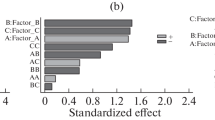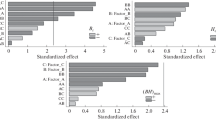Magnetic hysteresis properties (residual induction Br, coercivity Hc and maximum energy product (BH )max) of Fe – 27% Cr – 10% Co (27Kh10KA) hard magnetic powder alloy are assessed after different heat treatments. Optimum modes of heat treatment are determined using TRM251 programmed derivative-proportional-integral controllers. The magnetic characteristics of the specimens exceed those of the widely used alloy 25Kh15KYuBF with a higher cobalt content. The prospects of the Fe – 27% Cr – 10% Co (27Kh10KA) powder alloy for commercial production are considered.



Similar content being viewed by others
Notes
Here and below in the paper the content of elements is given in weight percent.
References
GOST 24897–81: Deformable Hard Magnetic Materials. Grades, Specifications and Methods of Control [in Russian], Gos. Kom. SSSR po Standartam, Moscow.
S. Jin, G. Y. Chin, and B. C. Wonsiewicz, “A low cobalt ternary Cr – Co – Fe alloy for telephone receiver magnet use,” IEEE Trans. Magn., MAG-16(1), 139 – 146 (1980).
M. L. Green, R. C. Sherwood, G. Y. Chin, et al., “Low cobalt CrCoFe and CrCoFe-X permanent magnet alloys,” IEEE Trans. Magn., MAG-16(5), 1053 – 1055 (1980).
M. L. Green, R. C. Sherwood, and C. C. Wong, “Powder metallurgy proceeding of CrCoFe permanent magnet alloys containing 5 – 25 wt.% Co,” J. Appl. Phys., 53(3), 2398 – 2400 (1982).
Chin Tsung Shune, Chen Tsann-Huei, and Chen Charn-Ying, “Magnetic properties and microstructures of Fe – Cr – 10 wt.% Co – M (M = Si/Ti/Ni/Mo/Ge/Ta) permanent magnet alloys,” J. Magn. Magn. Mater., 50, 214 – 222 (1985).
V. V. Nalimov and N. A. Chernova, Statistical Methods of Design of Extreme Experiments [in Russian], Nauka, Moscow (1965), 340 p. (Statgraphics Centurion XVI Software).
I. M. Milyaev, A. I. Milyaev, and V. S. Yusupov, “About the mechanism of formation of high-coercivity state in nanostructured hard magnetic alloys of the Fe – Cr – Co and Fe – Ni – Al – Co – Cu systems,” Metally, No. 3, 83 – 66 (2009).
The work has been performed within State Order No. 007-00129-18-00 with financial support of FTsNTP-2017 by State Contract of 26.09.2017 No. 14.579.21.0149.
Author information
Authors and Affiliations
Corresponding author
Additional information
Translated from Metallovedenie i Termicheskaya Obrabotka Metallov, No. 3, pp. 17 – 21, March, 2019.
Rights and permissions
About this article
Cite this article
Milyaev, I.M., Abashev, D.M., Alymov, M.I. et al. Magnetic Properties of Hard Magnetic Powder Alloy Fe – 27% Cr – 10% Co (27Kh10KA). Met Sci Heat Treat 61, 157–161 (2019). https://doi.org/10.1007/s11041-019-00392-4
Published:
Issue Date:
DOI: https://doi.org/10.1007/s11041-019-00392-4




